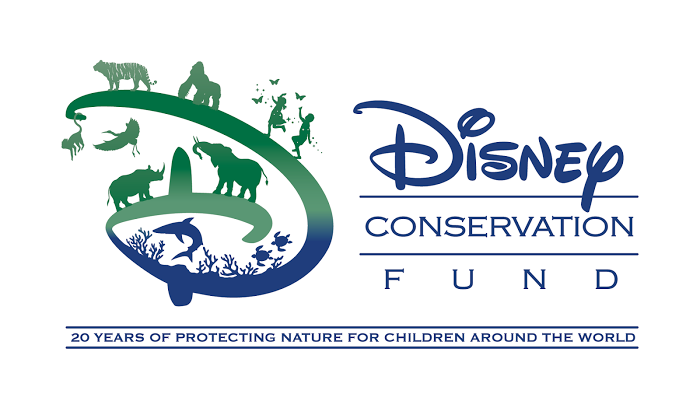Disney Conservation Fund Celebrates 20 Years with New Initiatives
The Disney Conservation Fund was launched on Earth Day in 1995 and so far has helped 330 nonprofit organizations and over 400 different animal species through donations and active participation in in the field. The Fund also has succeeded in connecting millions of children and families with nature. To celebrate two decades of success, the Conservation Fund is renewing their efforts by launching two tandem programs: Reverse the Decline and Increase the Time.
Reverse the Decline focuses Disney’s active participation in environmental and animal conservation programs. Their scientists, veterinarians, and other specialists will be working to create measurable methods and goals to help form strategies that can be applied in the field to create the best impact. Disney is working to bring professionals and organizations across a variety of areas into a closer working relationship to further research and community engagement. The Reverse the Decline initiative will focus on 10 animal groups to help protect habitats and prevent further species loss. See below for a full list and descriptions.
Increase the Time, the second part of the program, focuses on providing opportunities for kids to get outdoors. By promoting a connection with nature and direct involvement with conservation programs, Disney hopes to increase awareness of how integral man and nature really are in the big picture and foster the next generation of conservationists. The Conservation Fund provides donations to several nonprofit organizations, such as 4H, National Park Foundation, and National Wildlife Federation, to support outdoor and learning programs. Disney parks also is a major player is providing learning opportunities for kids, such as the Wilderness Explorers at Animal Kingdom where they can visit stations around the park and learn about different animals and cultures in between thrill rides with their families. Since 2012 the DCF increased their dedication to this area and has already helped connect over 50 million kids with the great outdoors.
For more information on the Disney Conservation Fund, such as programs and nonprofit organizations which receive donations, click here to visit their website.
The 10 threatened species targeted in the Reverse the Decline program include:
Big Cats: The Sumatran tiger is critically endangered as a result of poaching, both of tigers and their prey species; high rates of habitat loss as a result of human encroachment, deforestation, and forest fires; illegal wildlife trade; and the killing of tigers involved in human-tiger conflict. A consortium of Sumatra-based organizations aims to increase Sumatran tiger population levels by reducing poaching and illegal trade, encouraging community engagement, and improving the management of protected areas.
Butterflies: In many cultures, butterflies are considered beautiful symbolic creatures; but they are also important pollinators and indicators of environmental health and model organisms for studying the impact of habitat loss and climate change. Butterflies are threatened by loss, degradation and fragmentation of habitat. Disney is supporting work to identify the numerous at-risk butterfly species in Florida and California and to develop tailored conservation strategies for the most critical groups, including habitat restoration, captive breeding and reintroduction programs.
Coral Reefs: Living coral reefs are diverse ecosystems built by colonies of tiny animals (corals) that support a vast array of marine organisms and help provide natural protective barriers to coastal erosion. Numerous threats to coral reefs include coral bleaching, reduced growth and dying reefs as a result of climate change and changing ocean chemistry caused through acidification; in addition, widespread disease, coastal development, anchor damage, predation, and invasive species contribute to their decline. Disney is collaborating with experts in the Caribbean to protect the shrinking Bahamian reefs through a comprehensive study, training, and actions such as limiting harmful human contact with existing reefs, promoting natural coral reef ecosystem resilience, setting up coral nurseries, and experimenting with reef rehabilitation techniques.
Elephants: The African elephant is currently listed as a vulnerable species, due in large part to poaching driven by the illegal ivory trade. However, human-elephant conflict also contributes to elephant declines as many elephants are killed in retaliation for damaged crops and homes and even loss of human life. Disney is helping to reverse their decline by supporting work that addresses both poaching and human-elephant conflict, protects elephant habitat, promotes conservation legislation and helps train local conservationists.
Great Apes: Gorillas and chimpanzees are among our closest relatives, yet they are threatened as a result of human activities. Grauer’s gorillas and eastern chimpanzees are two endangered great ape species found in the Eastern portion of the Democratic Republic of the Congo. Their populations have dwindled due to hunting for bushmeat, capture for the illegal wildlife pet trade, and habitat loss and fragmentation. Disney’s support will help nonprofit organizations work with communities to reduce hunting, explore strategies to reintroduce rehabilitated apes to the wild, increase protection of great apes by local communities, and fund analysis and implementation of additional conservation strategies.
Migratory Birds: Cranes are iconic birds, especially in China, where the Siberian crane overwinters before traveling to its breeding grounds in northern Russia. The Siberian crane is critically endangered due to the loss of wetland habitat along its migratory route. Disney is supporting work to monitor and protect the relevant stopover sites along the birds’ more-than-three-thousand-mile migration path.
Monkeys: Disney is supporting work to protect two kinds of tamarins (tiny forest dwelling monkeys) – golden lion tamarins in Brazil and cotton-top tamarins in Colombia. Golden lion tamarins are threatened by forest habitat fragmentation due to urban development and Disney is supporting efforts in Brazil to restore the connections among enough forest fragments and golden-lion tamarin populations to save the species from extinction. In Colombia, Disney’s support is helping to protect and expand forest habitat, reduce the illegal wildlife trade, recycle more than three million plastic bags, and create alternative income sources for community members.
Rhinos: The critically endangered Sumatran rhino is the smallest member of the rhinoceros family and is known for its distinct hairiness. While the exact number of remaining Sumatran rhinos is difficult to determine, some estimate the population at less than a hundred. Disney’s support will help nonprofit organizations to address the threats of habitat loss and poaching by improving the range and effectiveness of anti-poaching patrols, increasing population numbers through a conservation breeding program, working with local communities to stop forest encroachment, and working with the Indonesian government to implement a national protection strategy.
Sea Turtles: The five species of endangered and threatened sea turtles in Florida face numerous threats including death in fisheries bycatch, loss of nesting and foraging habitats, and climate change. Disney’s support to Reverse the Decline of Florida’s sea turtles helps nonprofit organizations to combat the many threats to sea turtles by increasing public awareness, monitoring populations, and restoring marine habitat and beach nesting areas.
Sharks and Rays: Many species of sharks and rays around the world are considered endangered, impacted by factors such as overfishing, loss of habitat, and pollution. Sharks and rays cannot easily overcome these threats because they are slow to mature and reproduce relative to other fish. Disney is supporting the recovery of sharks and rays by supporting the scientific management of fisheries, reducing the demand for shark and ray products, and advancing research to secure protected status for threatened species.





